|
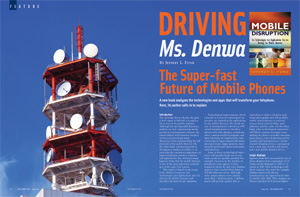 Introduction
Introduction
The old adage about whether the glass is half empty or half full is as applicable as ever in the mobile industry. Although US and especially European markets are now experiencing strong growth in entertainment contents, the initial failures with business-oriented services are preventing many Westerners from understanding the full potential of the mobile Internet. On the other hand, continued growth in the Japanese market (see Table 1), in particular the continuous appearance of improved phones, services, contents and applications, has convinced many Japanese firms that the mobile Internet is one of the most important technologies of the early 21st century.
This article is based on my recent book, Mobile Disruption: Key Technologies and Applications that are Driving the Mobile Internet, and describes the basis for my optimism.
Technological improvements, which I describe in terms of technological trajectories, are expanding the applications for the mobile Internet. The initial success of entertainment contents in 1999 caused manufacturers to introduce phones with color displays, polyphonic tones, cameras and Java programs, and these functions are supported by other technological improvements like faster microprocessors, larger memory, faster network speeds and infrared and smart card functions.
Some of these technological trajectories will quickly fizzle out as customer needs are quickly satisfied. For example, increases in the number of polyphonic tones appear to have stopped at about 40, and color displays appear to have reached their limit at 250,000 different colors. Although some camera phones now contain more than 1 million pixels, 2 million pixels will provide quality that is equivalent to what is found in traditional photographs and will probably enable camera phones to read and process finely printed URLs, mail addresses and bar codes. On the other hand, other technological trajectories will likely continue for many years, making the phone a portable entertainment player, a new marketing tool for retailers and manufacturers, a multi-channel shopping device, a navigation tool, a new type of ticket and money and a new mobile Intranet device.
Larger displays
Japanese firms have increased the size of phone displays from a maximum of 2.0 inches (on the diagonal) in 1999 to 2.4 inches in 2003. New technologies will likely continue this trend. For example, displays based on EL (Electro Luminescence) are expected to be widely used by early 2004. These displays are thinner and thus 20-30 percent lighter than TFT-based displays because they produce their own light and thus do not require a separate light source. Displays that are based on light emitting polymers (LEP) also create their own light; more importantly, by applying a thin polymer film to a plastic substrate, firms can make displays that are thinner than one-10th of an inch and can be rolled and folded. It may be possible to double, triple or even quadruple the size of existing phone displays over the next five years.
Processing and network speeds
More immediate effects are expected from increases in processing power, memory and network speeds since they can improve the user interface without increases in the size of the display. Increased processing and memory capabilities reflect Moore's Law. Decreasing semiconductor line widths have caused computing speed and memory size to roughly double every 18 months for the last 40 years. Similar trends are already seen in the mobile Internet, where the need for lower power consumption requires different circuit designs. Phones released in 2003 had speeds in the 100 MHz to 200 MHz range, and speeds greater than 500 MHz are expected by 2005. Phones with more than 5 megabytes of internal memory were also released; some could save 2,000 photos (taken with a 300,000 pixel camera), 2,000 ringtones (with 40 polyphonic tones) or 100 Java programs.
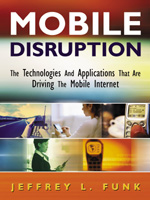 Network speeds will also increase primarily through the diffusion of third generation services. According to Qualcomm, these services may cause packet charges to fall as low as $0.022 per megabyte, or 1/500 of current i-mode charges. If data charges were to fall as low as $0.022 per megabyte, a three-minute MP3 file could be delivered for as little as $0.07, and a two-minute, medium resolution video clip could be delivered for a cost of approximately $0.13. Network speeds will also increase primarily through the diffusion of third generation services. According to Qualcomm, these services may cause packet charges to fall as low as $0.022 per megabyte, or 1/500 of current i-mode charges. If data charges were to fall as low as $0.022 per megabyte, a three-minute MP3 file could be delivered for as little as $0.07, and a two-minute, medium resolution video clip could be delivered for a cost of approximately $0.13.
We can also expect other forms of networks to play an important role in the mobile Internet. For example, phones with infrared functions that use the IrMC standard are already being used in Japan to connect phones with cash registers, concert ticket machines and each other (to play games and exchange name cards), and control televisions and karaoke machines.
New infrared standards like IrFM enable credit card information to be securely transferred between phones and cash registers. Non-contact smart cards relying on short-range radio transmission are used for transportation, concert tickets and pre-paid cards (at less than $50); phones containing these functions are expected as early as 2004.
Increased processing power, memory and network speeds can improve the mobile phone's user interface through more client-side processing of pre-loaded or downloaded programs. Java is currently the most popular program for doing this, although other programs exist and the competition between these programs is not over. Users can download a Java program once, and then either utilize the program independently of the network or in conjunction with data that is subsequently downloaded from the network. Alternatively, the Java program could be pre-loaded in the phone, eliminating the need for downloading the program at all.
Although games were initially the most popular content for Java programs, many news and other text-based sites now offer their contents as part of a Java program, since the use of Java programs can reduce the data downloading requirements of text and the user waiting time by as much as 80 percent.
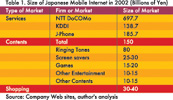 Faster processors with lower power consumption and larger memory will facilitate the use of Java and other client-side programs. Faster processing times reduce the time to activate a program, enabling the use of larger programs. Lower power consumption enables the longer use of these programs. Larger memories increase the size and number of programs that can be saved.
Faster processors with lower power consumption and larger memory will facilitate the use of Java and other client-side programs. Faster processing times reduce the time to activate a program, enabling the use of larger programs. Lower power consumption enables the longer use of these programs. Larger memories increase the size and number of programs that can be saved.
Although some phones can now save more than 100 Java programs, if all content providers offered their own Java programs from which users were expected to download information, users would still only be able to save a small fraction of these programs.
Another alternative is for content providers to format their contents for standard Java programs. Phones released in the spring of 2003 facilitate the use of such standard programs because they can access data for a Java program from different servers. Added advantages of defining standard programs (or "objects" for making these programs) would be less development costs for content providers and better control of viruses for service providers.
Increased processing power, memory and network speeds may also improve the user interface in more radical ways. Increased processing power will improve the performance of voice recognition systems and 3D contents. Single word voice recognition systems have been available for several years in Japanese phones, and it appears that user resistance to making voice commands is a bigger bottleneck than actual technical problems.
As for 3D contents, phones with 50 MHz processors can display 10,000 "polygons" per second, while phones with 500 MHz processors can display 640,000 polygons per second; the latter will probably be available in phones in 2005 and is now available in the newest versions of the Playstation2. While most 3D contents are screen savers and games, 3D images of products might facilitate mobile shopping, 3D maps might facilitate navigation services, and 3D representations of data might facilitate business applications.
 Entertainment Entertainment
Games, ringtones, screen savers and other entertainment contents are already making the mobile phone a portable entertainment player, and faster network speeds, increased processing power, Java and 3D rendering techniques will reinforce this trend. The success of KDDI's vocal ringtone service (more than 3 million 45-second songs were downloaded in June 2003) suggests that lower packet charges will make the downloading of music and video on phones commonplace. However, it is the unexpected changes that are of greater interest, and the mobile Internet will likely create its own forms of entertainment, just as the radio, TV, video recorder and Internet have done.
Java-based and 3D screen savers became possible with the phones released in 2002. These screen savers have menus that enable users to manipulate the 3D images on the screen and raise pets like fish on other screen savers, an activity that was popularized in Bandai's Tamogotchi toys. Phones released in 2003 can activate these Java programs with an incoming call or mail message, and the Java program can be customized for the caller.
Even better processors that have lower power consumption may enable screen savers to be used as browsers where Java programs or contents are downloaded from a Java-based screen saver. The use of screen savers as an entry point for games is an obvious candidate, with game providers offering a screen saver as part of the Java game. If the PC browser wars in the mid 90s are any guide, a wide variety of content providers, retail outlets and manufacturers may give away such screen savers as a way to guide consumers to their sites.
Mobile marketing
Phones have already become a new marketing tool for retailers and manufacturers due to the low cost of sending mail to mobile phone users. More than 100 retailers and manufacturers are using the mobile Internet to send discount coupons, conduct surveys and offer free samples to registered users via mobile mail. For example, more than 100,000 Japanese redeem coupons via their mobile phones each month with Japan's leading video retailer, Tsutaya Online, and the total could eventually exceed 1 million a month.
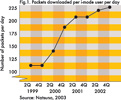 New technologies like in-store bar code readers, short-range infrared and Java offer additional ways for retailers to develop stronger relationships with the young market. For example, Jeansmate uses in-store scanners to read the bar codes displayed on the phone's screen in order to identify the customer and integrate its mobile and POS databases.
New technologies like in-store bar code readers, short-range infrared and Java offer additional ways for retailers to develop stronger relationships with the young market. For example, Jeansmate uses in-store scanners to read the bar codes displayed on the phone's screen in order to identify the customer and integrate its mobile and POS databases.
Furthermore, when a customer purchases a product with or without a discount coupon, their name is displayed on the cash register. Jeansmate can register or update the customer's mobile mail addresses by inserting a special device into one of the customer's phone ports; the device activates the mail function and automatically sends mail to the Jeansmate server.
It is also possible to use the phone as a point card for loyalty programs in place of magnetic or paper point cards. One method is to use a bar code as the user's ID and provide point information to customers when purchases are made. A second method is to use the phone's infrared function to validate the user ID. Users download a Java program activated by the infrared connection.
 Multi-channel shopping
Multi-channel shopping
While it is possible to use the mobile phone by itself to purchase products, the small screens and keyboards make it difficult to search for products, which is the largest advantage to finding books or travel services on the PC Internet. This is why most of the products purchased with a mobile phone are selected from personalized mail services that provide information on recent releases for a specific artist or genre -- a severe limitation.
The fastest growing segment of mobile shopping combines sites with magazine advertisements and catalogs. More than 50 fashion-related magazines offer mobile shopping services, and many of them believe that higher resolution cameras and faster processing speeds will drive growth in this market. Instead of users scrolling through several menu screens or inputting a URL, they can use camera phones to photograph a URL or bar code that is printed in a magazine and the phone's processor uses a pattern recognition algorithm to identify the URL.
Television broadcasters are also attempting to integrate mobile Internet sites with their programs in order to provide paid information services or sell products that are used in the programs. Television broadcasters hope that some young women will be interested in purchasing the clothing and cosmetics that are used by actresses or in accessing information about the program or the program locations. It is possible that infrared technologies will facilitate the linkage of television programs and mobile Internet sites in the way that camera phones might do this for magazines.
Navigation
Lower packet charges, larger displays and 3D rendering techniques may enable mobile phones to finally become an important portable navigation guide. The basic problem with current GPS devices is that they use too much power for their inclusion in mobile phones. One alternative is to use network-assisted GPS, which requires less power, has less effect on phone weight and in some cases can be combined with base-station triangulation techniques which are useful when the phone is inside or near a building. KDDI currently uses this approach with its cdma2000 services. The disadvantage of network-assisted GPS is that it requires a connection to the network, which can be time consuming (45 seconds) and cost more than $0.07 per connection at current packet charges. Monitoring an employee's location every five minutes for 10 hours would cost almost $80 per day -- as compared to almost zero for a conventional GPS device.
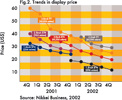 Larger displays and/or 3D rendering techniques are also needed. Current displays are too small for users to understand their location on the map.
Larger displays and/or 3D rendering techniques are also needed. Current displays are too small for users to understand their location on the map.
Although GPS and a compass function help somewhat, currently they are insufficient for effective map usage. This is why map services have less than 10 percent the number of subscribers and less than 1 percent the traffic of train and bus information services.
Restaurant search services, which charge restaurants to be on the site, also have far more traffic and income than the map services.
Tickets and money
Improvements in infrared and non-contact smart card technologies and increases in processing speeds can enable phones to be used as tickets and money, thus continuing the evolution from physical to electronic money that was started with credit cards 50 years ago.
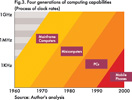 Credit card information is already being exchanged between phones and cash registers using the IrFM standard in Korea, and such phones are expected to appear in Japan in 2004. More than 50 million non-contact smart cards are currently in use in Asia, primarily in transportation applications. They are also used as money in convenience stores, principally in Hong Kong, and are now being used as concert tickets in Japan.
Credit card information is already being exchanged between phones and cash registers using the IrFM standard in Korea, and such phones are expected to appear in Japan in 2004. More than 50 million non-contact smart cards are currently in use in Asia, primarily in transportation applications. They are also used as money in convenience stores, principally in Hong Kong, and are now being used as concert tickets in Japan.
Placing these smart card functions in phones will likely expand the existing applications for these cards. Phones will reinforce a single standard, which will reduce technological uncertainty and the cost of readers and may enable supporters of such smart cards to create a network of stores and users that can challenge credit card networks.
Furthermore, faster processors in phones enable the use of biometrics and the verification of user identification, which will facilitate the purchase of more expensive items without the need for signatures or other identification.
Mobile Intranet
The rapid diffusion of Internet-compatible phones and several technological trajectories has finally led to strong growth in business users. There are more than 500,000 subscribers to various mobile mail services that facilitate access to PC mail. Several times more business people probably do this on their own or rely on their firm to provide the service.
Furthermore, there are probably between 100,000 and 200,000 business people accessing information in corporate databases from their mobile phones.
The largest applications in the accessing of corporate databases are delivery, maintenance, construction and sales.
 Some delivery companies have replaced their proprietary handsets with mobile phones and enable customers to request delivery times on both their PCs and mobile phones. Maintenance departments send information about the next customer to workers via mobile mail that often includes URLs for access of more detailed information. Some delivery companies have replaced their proprietary handsets with mobile phones and enable customers to request delivery times on both their PCs and mobile phones. Maintenance departments send information about the next customer to workers via mobile mail that often includes URLs for access of more detailed information.
Construction companies send mail to their workers asking them to update their work status; the project management people use this data to set better schedules for materials and specialists like plumbers and electricians.
Manufacturing companies allow their sales personnel to access sales, price and inventory information and input orders on their mobile phones.
Improved displays, larger Java programs and 3D imaging techniques will expand all of these applications. Java programs reduce waiting time and data downloading requirements, and many firms are planning to use Java-based screen savers as an entry point for information access by their employees.
3D rendering techniques can increase the amount of information that is represented on one screen.
These technological improvements will also drive changes in the overall architecture of the mobile Internet, which brings us to the subject of platform management.
Platform management
The number of applications in the mobile Internet will continue to grow, which will require service providers to offer third-party content and software.
Service providers that primarily rely on their own content and applications will likely end up in the same situation that Apple Computer found itself in.
On the other hand, those that are "too open" and cede control of critical interfaces to suppliers are likely to end up in the same situation that IBM found itself in.
Furthermore, the sheer number of these interfaces suggests that service providers will struggle to control all of them, particularly since phone manufacturers and content, technology and software providers are aiming for the same prize. Already, many of the latter firms claim that they are the ones who determine the phone specifications in Japan through their recommendations to the service providers.
The moves from markup languages like c-HTML to more sophisticated user interfaces will redefine the critical interfaces and thus the architecture of the mobile Internet.
For example, if standard Java programs emerge that facilitate an overall move by all content providers towards Java, the owners of these Java programs will probably increase their power in the market. The emergence of standard application processors, 3D rendering techniques, GPS applications, infrared techniques and Intranet applications will also have an enormous impact on the overall architecture for the mobile Internet. Growth in the mobile Internet and the battle for control of it has only just begun. @
|